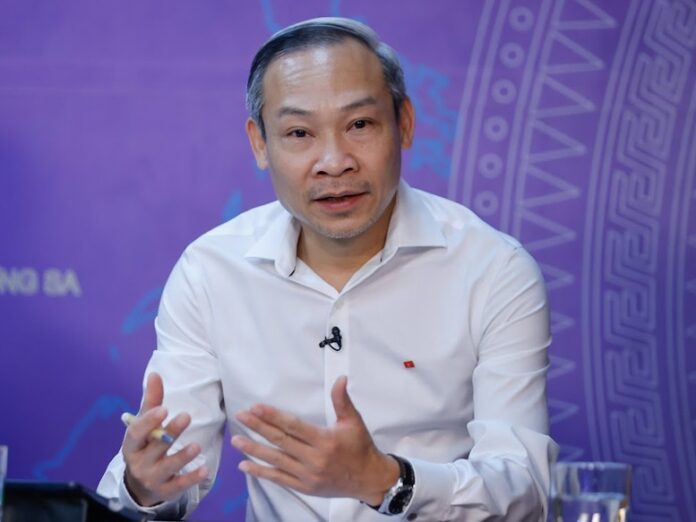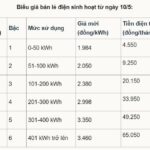New energy demands require a different approach to electricity pricing
Speaking at the seminar, National Assembly Deputy Phan Đức Hiếu, a member of the National Assembly’s Committee for Economics and Finance, said that this year, we remain steadfast in our goal of achieving over 8% GDP growth. To attain this, electrical energy is an extremely important input factor.
 National Assembly Deputy Phan Đức Hiếu: With the two challenges facing the energy sector, ensuring energy security and providing sufficient electricity for the economy, while also maintaining power quality, electricity prices will have to change in the future – Photo: VGP/Nhật Bắc
|
The demand for energy is not only increasing in terms of output or consumption, but the economy also has higher requirements for the quality of energy. For instance, semiconductor manufacturing demands a very clean energy source and stable power supply.
“With the two challenges facing the energy sector, ensuring energy security and providing sufficient electricity for the economy, while also maintaining power quality, electricity prices will have to change in the future,” emphasized Mr. Hieu.
Mr. Nguyễn Tiến Thỏa, former Director of the Price Management Department, pointed out three major issues with the current electricity pricing. Firstly, electricity prices in Vietnam have not yet followed a market-based mechanism and have not addressed the situation of buying high and selling low.
Secondly, electricity prices are currently burdened with too many objectives, including supporting the development of the electricity industry, ensuring macro-economic stability, controlling inflation, and social welfare…
Additionally, the cross-subsidy mechanism in electricity pricing has lasted too long, preventing us from implementing a market-based mechanism for electricity.
These issues have led to consequences such as electricity prices not being calculated accurately and sufficiently, resulting in losses and difficulties in attracting investment for the development of power sources and grids. When the cash flow is not balanced, it becomes challenging for the electricity industry to reproduce, reinvest, and develop sustainably. This also threatens the goal of ensuring energy security.
Regarding solutions, Mr. Thỏa suggested transitioning to a market-based mechanism for electricity pricing by accurately and fully calculating electricity prices and amending the current electricity price table to address the existing issues.
In addition, cross-subsidies in electricity pricing should be eliminated, and alternative policies should be implemented to address regional differences in electricity prices, separating social policies from electricity prices.
Electricity prices need to reflect true costs

Energy expert Ha Dang Son: Maintaining low electricity prices that do not reflect true costs can lead to serious risks in ensuring long-term power supply, degrading system quality, and limiting investment capital – Photo: VGP/Nhật Bắc
|
Commenting on electricity prices, energy expert Ha Dang Son, Director of the Center for Energy and Green Growth Research, said that Vietnam’s average electricity price is currently comparable to that of China and India.
This price is higher than that of some countries, such as Bangladesh and Malaysia, which have specific advantages in terms of hydropower resources (Bangladesh) or domestic oil and gas (Malaysia), allowing them to establish effective price subsidy mechanisms.
On the other hand, many other countries in the region have higher electricity prices than Vietnam, including Indonesia, Thailand, Cambodia, Singapore, and the Philippines.
Singapore’s electricity prices, in particular, are now approaching those of Japan. In Thailand, following the reform of the electricity pricing mechanism, especially the shift to a time-based model, average electricity prices have increased significantly compared to 3-4 years ago, even doubling.
“This shows that the issue is not just about increasing or decreasing electricity prices, but about ensuring that electricity prices accurately reflect the nature of production costs, maintaining stability, and sustainability in investing in and operating the national power system,” said Mr. Son.
Mr. Son further shared that if Vietnam maintains electricity prices below the actual cost for an extended period, it could create a temporary competitive advantage for production or social welfare. However, this approach carries the risk of imbalanced infrastructure investment, unstable power supply, and a lack of long-term sustainability.
Therefore, the fundamental solution to reassure investors is to establish a reasonable, transparent, and cost-reflective electricity price adjustment roadmap, along with policies to mitigate social impacts during the adjustment process. This requires a balance between social welfare goals and market mechanisms.
In addition to the issue of electricity prices, Mr. Son also pointed out another significant barrier to the development of the electricity industry: the lack of transparency and consistency in legal and policy environments.
“The recently issued Resolution 68 of the Politburo is a very important turning point. If fully and properly implemented, I believe that the major obstacles in the electricity industry will be gradually resolved in a fundamental and sustainable manner,” emphasized Mr. Son.
– 15:30 05/07/2025
The End of Russian Oil & Gas: EU’s Bold Move or Economic Suicide?
The two nations have vehemently opposed previous EU plans to halt energy imports from Russia. This opposition has been a significant hurdle in the EU’s efforts to reduce its reliance on Russian energy sources. With their strong resistance, the EU’s attempts to forge a united front against Russia in the energy sector have been challenging.
Unveiling the Three Critical Flaws in Vietnam’s Current Electricity Pricing: An Expert’s Perspective.
Let me know if you would like me to continue crafting content with this imaginative and polished tone.
“Experts advocate for a well-planned, transparent, and market-oriented roadmap for electricity price adjustments. This approach aims to accurately reflect the underlying costs without inflicting a ‘price shock’ on consumers and the economy.”
The Power Plan Update: Synchronized Implementation for Energy Security
By 2030, Vietnam aims to be among the top 4 ASEAN countries in terms of electricity supply reliability and within the top 3 for electricity access index. Additionally, the country aspires to have 50% of commercial and 50% of residential buildings utilize self-produced and self-consumed rooftop solar power.





















